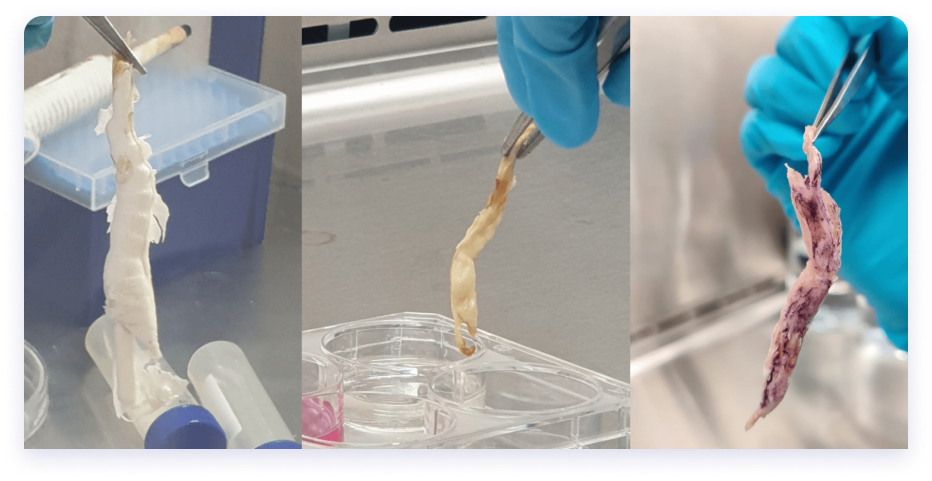Diversifying the global food supply with alternative proteins will safeguard our natural resources
Global demand for meat is expected to rise by at least 50 percent by 2050.1 Meeting this demand with conventional meat alone would accelerate pollution and deplete scarce natural resources. Alternative proteins—meat and seafood made from plants, fermentation, or cultivated from animal cells—use a fraction of the land and water required by conventional meat, generate fewer greenhouse gases (GHGs), and reduce the flow of pollutants into communities and ecosystems. To safeguard our natural resources, policymakers should support alternative proteins by making public investments in research, development, and commercialization.
Alternative proteins are land-efficient
Alternative proteins use resources directly, without cycling them through animals, and thus require significantly less land. Plants provide nearly two-thirds of the global protein supply on only one-fourth of all agricultural land.2 A shift to alternative proteins could free up twice as much land as China and India combined.3 With reforestation and carbon sequestration, the freed-up land would further mitigate climate change—potentially removing 26 gigatons of carbon dioxide equivalent per year, about half of current global emissions.4 Moreover, by mitigating deforestation and habitat loss, alternative proteins can serve as a key strategy to preserve biodiversity.
Alternative proteins generate fewer GHGs
Alternative proteins have significantly smaller GHG footprints as they do not require raising methane-emitting livestock and growing crops for feed. They provide a crucial tool to decarbonize food systems—which account for over a third of global GHG emissions—and meet Paris Agreement goals.5 If alternative proteins rise to half the global protein market, including dairy, they would mitigate 5 gigatons of carbon dioxide equivalent annually, and agriculture and land-use GHG emissions would decline by 31 percent by 2050 instead of increasing.6 By capturing just 11 percent of the protein market by 2035, alternative proteins can slash GHGs on a scale roughly equal to decarbonizing the entire aviation industry.7
Alternative proteins are water-efficient and can address water scarcity
Only 0.003 percent of Earth’s water is available freshwater, and over two billion people currently live in countries with inadequate water supply.8 Water scarcity is projected to worsen in the coming decades, especially in drought-susceptible areas like the American West, including the Colorado River—for which more than three-quarters of water withdrawals are related to agriculture.9 In fact, agriculture is the largest user of freshwater, accounting for 70 percent of withdrawals globally.10 Plant-based meat can reduce water use by up to 99 percent and cultivated meat by 66 percent (compared to conventional beef).11 As water becomes a limited resource, alternative proteins offer a water scarcity solution.12
Alternative proteins cause significantly less air and water pollution
By using plants, fermentation, or cell cultivation instead of livestock, the production of alternative proteins does not emit the same toxic air pollutants—including ammonia, particulate matter, and hydrogen sulfide—as conventional meat production.13 Similarly, because there is no animal waste to discharge and fewer crops and fertilizers are needed, alternative proteins reduce the discharge of nitrogen and phosphorus, which stimulate the growth of algal blooms that impair water quality.14 A shift toward alternative proteins can keep our air and water clean, improving the health of communities and ecosystems while meeting increasing protein demand.
Policymakers should invest in alternative proteins for a secure, sustainable food supply
Supporting alternative protein innovation and commercialization will increase food security. Beyond their significant environmental benefits, alternative proteins expand consumer choice and promote national security by increasing supply chain resilience.15 In addition, transitioning to alternative proteins could support 83 million jobs and generate $700 billion in economic value by 2050 globally.16 Like renewable energy, technologies enabling alternative proteins are key environmental solutions made possible by scientific breakthroughs. To unlock alternative proteins’ full potential, the world’s governments should collectively invest $10.1 billion annually in research, development, and commercialization.17 With sufficient public investment, alternative proteins can deliver a secure food supply for a growing population while protecting the environment and global stability.
Addressing environmental challenges with alternative proteins
The comprehensive impact of embracing alternative proteins extends beyond addressing the above environmental issues—it is a holistic approach towards a sustainable and resilient future.
Climate
Scaling up alternative proteins is a high-impact solution to the global climate crisis.18 Animal agriculture produces 20 percent of GHG emissions globally, which come from animal feed production, animal digestion, and waste.19 Livestock alone account for nearly 40 percent of U.S. methane emissions.20 The Paris Agreement’s 1.5°C warming limitation goal cannot be met unless conventional meat consumption declines.21
Air pollution
Alternative proteins can help improve community health as they generate significantly less pollution. In the United States, a shift to alternative proteins could prevent approximately 12,000 deaths per year from a reduction in air pollution alone.22 As air pollution disproportionately impacts low-income and minority communities, alternative proteins can promote environmental justice within the food system.
Deforestation
We are running out of room for conventional protein production, which has led to the clearing of forests and other ecosystems for pasture and cropland. Shifting just 20 percent of per-capita ruminant meat consumption to alternative proteins by 2050 would offset future increases in global pasture area and cut annual deforestation—and related carbon emissions—in half.23
Biodiversity
Conversion of land to agriculture is linked to 70 percent of all projected terrestrial biodiversity loss in coming decades.24 Large-scale biodiversity loss can destabilize the water cycle, climate, and other global systems and lead to food scarcity, nutritional deficits, and economic insecurity. The land efficiency of alternative proteins can help reverse deforestation and habitat loss trends, preserving biodiversity.





